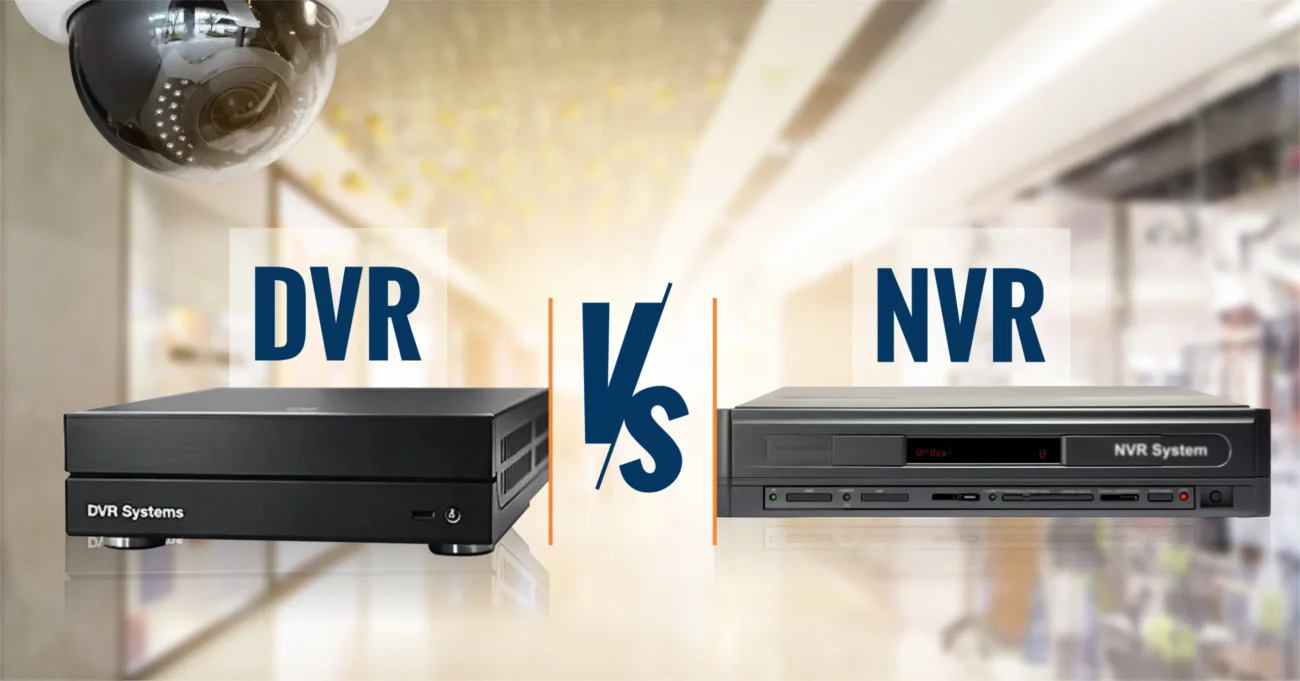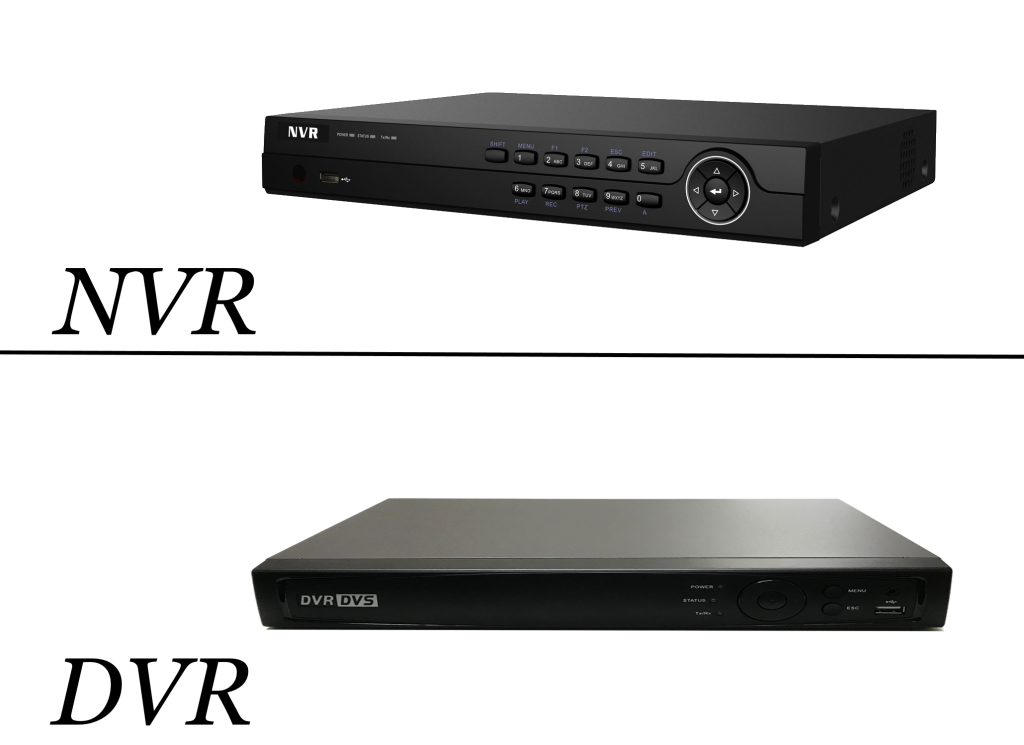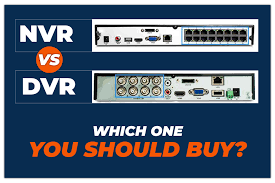Blog
Understanding DVR vs NVR: Which Surveillance System is Right for You?

DVR vs NVR:- In a world where security is paramount, choosing the right surveillance system can feel overwhelming. Whether you’re safeguarding your home or managing a business, the decision between DVR and NVR systems is crucial. DVR (Digital Video Recorder) systems have long been the go-to choice for traditional analog cameras, offering a straightforward approach to recording and playback. On the other hand, NVR (Network Video Recorder) systems leverage the power of digital IP cameras, providing superior image quality and more flexible installation options. But how do these two systems compare in terms of features, ease of use, and scalability? Understanding the key differences can help you make an informed decision tailored to your unique needs. Join us as we delve into this important comparison, unveiling the strengths and weaknesses of each option, and guiding you towards the perfect surveillance solution for your safety and peace of mind.

What is DVR (Digital Video Recorder)?
A Digital Video Recorder, commonly known as a DVR, is a system used to record video footage from analog security cameras. It digitizes analog signals received from the cameras and stores them on a hard drive for later playback and review. The DVR system typically includes a central unit where the video footage is processed, stored, and managed. This central unit is connected to the cameras via coaxial cables, which transmit the video signals.
DVR systems have been a staple in the surveillance industry for many years, providing a reliable way to monitor and record activities in various settings. They are known for their ease of use and straightforward setup, making them a popular choice for homeowners and small business owners. The video footage recorded by a DVR can be accessed locally or remotely, depending on the system’s capabilities, allowing users to keep an eye on their property from anywhere.
One of the key features of DVR systems is their ability to compress video data, which helps in maximizing storage space and ensuring efficient use of available resources. This compression technology, along with the ability to record continuously or based on motion detection, makes DVR systems a versatile and practical solution for many surveillance needs. However, it’s important to note that DVR systems are generally best suited for environments where the use of analog cameras is preferred or where existing analog infrastructure is already in place.
What is NVR (Network Video Recorder)?
A Network Video Recorder, or NVR, is a system designed to record video footage from digital internet protocol (IP) cameras. Unlike DVR systems, which rely on analog signals, NVR systems work with digital signals, offering higher image quality and more advanced features. The NVR system typically consists of a central unit that records, stores, and manages video footage, but the cameras connected to the NVR communicate via a network, either wired or wireless.
NVR systems are known for their flexibility and scalability, making them an ideal choice for larger installations or those requiring high-definition video. IP cameras used with NVR systems not only provide superior image quality but also support advanced functionalities such as facial recognition, motion detection, and analytics. These features can significantly enhance the overall effectiveness of the surveillance system, providing more detailed and actionable information.
One of the major advantages of NVR systems is the ease of installation and the ability to integrate with existing network infrastructure. Since IP cameras can be connected over a network, there is no need for extensive cabling as required by DVR systems. This makes NVR systems particularly suitable for modern buildings and large-scale deployments where minimal disruption is desired. Additionally, NVR systems offer remote access capabilities, allowing users to monitor their property from anywhere with an internet connection, thus providing greater flexibility and control.
Key Differences Between DVR and NVR
When comparing DVR and NVR systems, one of the most significant differences lies in the type of cameras they use. DVR systems are designed to work with analog cameras, while NVR systems are compatible with IP cameras. This fundamental difference affects not only the image quality but also the overall functionality and capabilities of the surveillance system. Analog cameras typically offer lower resolution and fewer advanced features compared to IP cameras, which can capture high-definition footage and support sophisticated analytics.
Another critical difference is the method of data transmission and storage. In DVR systems, video signals are transmitted via coaxial cables directly to the DVR unit, where they are digitized and stored. This requires a more complex cabling setup and limits the placement flexibility of the cameras. On the other hand, NVR systems utilize network connectivity to transmit video data, allowing for more flexible camera placement and easier integration with existing network infrastructure. This network-based approach also enables more straightforward scalability, as additional cameras can be added to the system without significant changes to the cabling.
The user experience and management capabilities also differ between DVR and NVR systems. DVR systems tend to be more straightforward and may offer fewer advanced features, making them easier to use for individuals who need basic surveillance functionality. In contrast, NVR systems often come with more sophisticated software, providing enhanced control, remote access, and advanced analytics. This makes NVR systems more suitable for users who require detailed monitoring and analysis capabilities. Overall, the choice between DVR and NVR systems will largely depend on the specific needs and preferences of the user, as well as the intended application of the surveillance system.
Advantages of DVR Systems
One of the primary advantages of DVR systems is their cost-effectiveness. Since DVR systems use analog cameras, which are generally less expensive than IP cameras, the overall cost of setting up a DVR system can be lower. This makes DVR systems an attractive option for budget-conscious users who need reliable surveillance without breaking the bank. Additionally, many users may already have existing analog cameras and coaxial cabling, making it more economical to upgrade to a DVR system rather than replacing the entire setup with an NVR system.
Another significant advantage of DVR systems is their simplicity and ease of use. DVR systems are known for their straightforward installation and operation, making them accessible to individuals with limited technical knowledge. The plug-and-play nature of DVR systems means that users can quickly set up their surveillance system and start monitoring their property without the need for extensive configuration. This simplicity also extends to the user interface, which is typically designed to be intuitive and user-friendly, ensuring that users can easily navigate and manage their recordings.
DVR systems also offer reliable performance and durability. The use of coaxial cables for video transmission ensures a stable and consistent connection between the cameras and the DVR unit, minimizing the risk of signal interference or loss. Additionally, DVR systems often come with robust hardware components designed to withstand continuous operation, making them a dependable choice for long-term surveillance needs. The ability to record and store video footage locally on a hard drive also provides added security, as users can access their recordings even if the network connection is disrupted.

Advantages of NVR Systems
NVR systems offer several advantages that make them a compelling choice for modern surveillance needs. One of the most notable benefits is the superior image quality provided by IP cameras. IP cameras used with NVR systems can capture high-definition video, delivering clear and detailed footage that is essential for accurate monitoring and identification. This higher resolution is particularly beneficial in environments where precise image quality is crucial, such as in commercial settings or areas with high-security requirements.
Flexibility and scalability are other key advantages of NVR systems. The use of network connectivity allows IP cameras to be placed virtually anywhere within the network’s range, providing greater flexibility in camera placement and coverage. This is especially useful in large or complex environments where extensive cabling would be impractical. Additionally, NVR systems can be easily expanded by adding more IP cameras to the network, making them ideal for growing businesses or evolving security needs. This scalability ensures that the surveillance system can adapt to changing requirements without significant reconfiguration.
NVR systems also offer advanced features and functionalities that enhance the overall effectiveness of the surveillance system. IP cameras often come equipped with capabilities such as motion detection, facial recognition, and video analytics, providing valuable insights and automated alerts. These features can help users proactively address security concerns, improve response times, and gain a deeper understanding of their environment. Furthermore, NVR systems typically support remote access, allowing users to monitor their property from anywhere with an internet connection. This remote access capability provides added convenience and peace of mind, as users can stay connected to their surveillance system at all times.
Factors to Consider When Choosing Between DVR and NVR
When deciding between DVR and NVR systems, one of the first factors to consider is the type of cameras you need. If you already have analog cameras in place or prefer a more cost-effective option, a DVR system may be the better choice. However, if you require high-definition video and advanced features, an NVR system with IP cameras would be more suitable. Assessing your specific surveillance requirements and the level of detail needed in the footage can help determine which system is the best fit.
Another important consideration is the installation and infrastructure requirements. DVR systems rely on coaxial cables for video transmission, which may necessitate more extensive cabling and installation efforts. This can be a limiting factor in larger or more complex environments where running cables is challenging. In contrast, NVR systems use network connectivity, allowing for easier and more flexible camera placement. If your property already has a robust network infrastructure, an NVR system can be seamlessly integrated, reducing installation complexity and cost.
Scalability and future-proofing are also crucial factors to consider. If you anticipate needing to expand your surveillance system in the future, an NVR system’s scalability can be a significant advantage. The ability to add more IP cameras to the network without extensive reconfiguration ensures that the system can grow with your needs. Additionally, the advanced features and higher image quality offered by NVR systems can provide a more future-proof solution, accommodating emerging technologies and evolving security requirements. Evaluating your long-term surveillance goals and potential growth can guide you in making the right choice between DVR and NVR systems.
Installation and Setup: DVR vs. NVR
The installation process for DVR systems generally involves connecting analog cameras to the DVR unit using coaxial cables. This requires running cables from each camera to the central DVR unit, which can be labor-intensive, especially in larger installations. The physical connection ensures a stable and reliable transmission of video signals, but it also limits the flexibility in camera placement. The DVR unit itself typically needs to be positioned in a secure and accessible location, as it will house the hard drive where video recordings are stored.
In contrast, the installation of NVR systems is often more straightforward, thanks to the use of network connectivity. IP cameras can be connected to the NVR unit via a wired Ethernet connection or wirelessly, depending on the network setup. This flexibility allows for easier and more strategic placement of cameras, as they do not need to be physically tethered to the NVR unit. The use of Power over Ethernet (PoE) technology further simplifies the setup by enabling both power and data transmission over a single Ethernet cable, reducing the need for additional power sources.
Setting up the software and configuring the system is another aspect where DVR and NVR systems differ. DVR systems typically come with a user-friendly interface that simplifies the initial setup and ongoing management. Users can easily navigate the settings, adjust recording schedules, and playback footage. NVR systems, on the other hand, often offer more sophisticated software with advanced features and customization options. While this can provide greater control and functionality, it may also require a steeper learning curve for users who are not familiar with network-based systems. Ensuring proper configuration and understanding the software capabilities is essential for maximizing the benefits of an NVR system.

Cost Comparison: DVR vs. NVR
The cost of setting up a DVR system is generally lower than that of an NVR system. Analog cameras used in DVR systems are typically less expensive than their IP counterparts, making the initial investment more affordable. Additionally, if you already have existing analog cameras and coaxial cabling, upgrading to a DVR system can be a cost-effective option, as it allows you to leverage the existing infrastructure. The DVR unit itself is also relatively affordable, providing a budget-friendly solution for basic surveillance needs.
However, it’s important to consider the long-term costs and potential savings associated with NVR systems. While the initial investment in IP cameras and network equipment may be higher, the advanced features and higher image quality can provide greater value over time. The flexibility and scalability of NVR systems can also lead to cost savings in the long run, as the ability to easily expand the system and integrate with existing network infrastructure reduces the need for extensive reconfiguration and additional cabling. Furthermore, the advanced analytics and remote access capabilities offered by NVR systems can enhance overall security and efficiency, potentially reducing operational costs and improving response times.
Maintenance and ongoing costs are another factor to consider when comparing DVR and NVR systems. DVR systems may require more frequent maintenance due to the physical connections and wear and tear on coaxial cables. In contrast, NVR systems, with their network-based connectivity, may have lower maintenance requirements and longer lifespans for the cameras and equipment. Additionally, the ability to access and manage the NVR system remotely can reduce the need for on-site visits and maintenance, further contributing to cost savings. Evaluating the total cost of ownership, including initial investment, maintenance, and potential savings, can help you make an informed decision between DVR and NVR systems.
Conclusion: Making the Right Choice DVR vs NVR for Your Surveillance Needs
Choosing between DVR and NVR systems ultimately depends on your specific surveillance requirements, budget, and future plans. DVR systems offer a cost-effective and straightforward solution for users who need basic surveillance with analog cameras. Their simplicity and ease of use make them an excellent choice for homeowners and small businesses looking for reliable security without the need for advanced features. If you have existing analog infrastructure or prefer a more traditional setup, a DVR system can provide the necessary functionality at an affordable price.
On the other hand, NVR systems provide superior image quality, greater flexibility, and advanced features that cater to modern surveillance needs. The use of IP cameras allows for high-definition video and sophisticated analytics, making NVR systems ideal for larger installations or environments where detailed monitoring is crucial. The scalability and ease of integration with existing network infrastructure also make NVR systems a future-proof solution, capable of adapting to evolving security requirements. If you require a more robust and versatile surveillance system with remote access capabilities, an NVR system is the way to go.
Ultimately, the decision between DVR and NVR systems should be based on a thorough assessment of your specific needs, budget, and long-term goals. By understanding the key differences and advantages of each option, you can make an informed choice that ensures the safety and security of your property. Whether you opt for a DVR system’s simplicity and cost-effectiveness or an NVR system’s advanced features and flexibility, the right surveillance solution will provide peace of mind and enhance your overall security.

